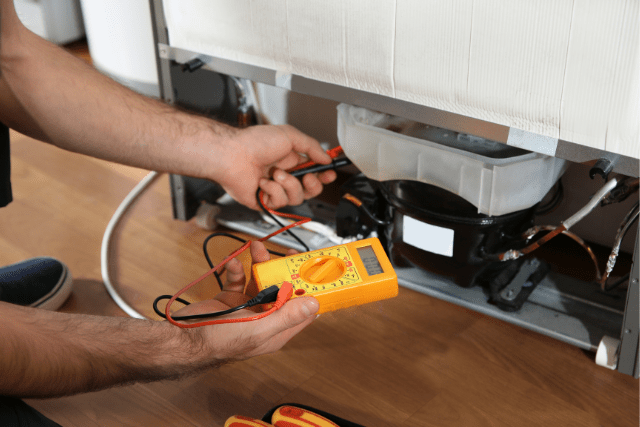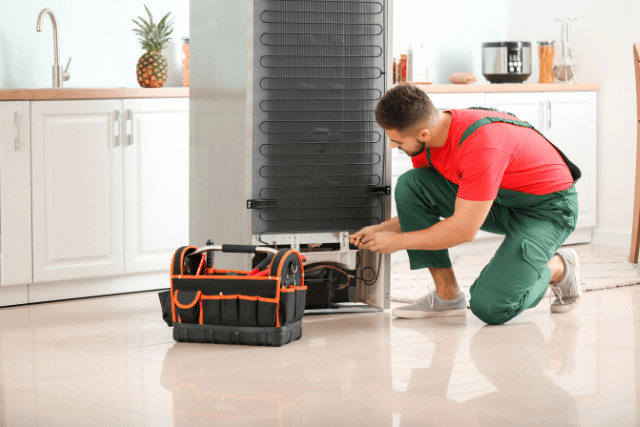Is your refrigerator not cooling properly? Don’t worry; we are here to assist you! This article will guide you through troubleshooting tips to help identify and fix the issue.
From checking and cleaning the condenser coils to examining the evaporator fan motor, let us follow step-by-step instructions to get your refrigerator back to its optimal cooling state.
Key Takeaways
- Insufficient cold temperature inside is a main sign of a malfunctioning refrigerator.
- Regularly check and clean condenser coils to ensure proper airflow.
- Listen for unusual noises and a lack of airflow from the evaporator fan motor.
- Test the temperature control thermostat, check the compressor, and start the relay for any signs of damage or malfunction.
Common Causes of Refrigerator Cooling Problems
Your refrigerator may not be cooling properly due to several common causes. Identifying these issues is crucial for troubleshooting and fixing the cooling problem.
So, let’s check the most common causes of refrigerator cooling problems and the steps you can take to solve them.
- Faulty Thermostat: The thermostat regulates the temperature inside the refrigerator. If it malfunctions, it can cause the cooling system to run continuously or not at all.
- Dirty Condenser Coils: Over time, dust and debris can accumulate on the condenser coils, hindering their ability to release heat. This can result in inadequate cooling.
- Inadequate airflow: Proper airflow is essential for maintaining consistent cooling throughout the refrigerator.
- Malfunctioning Compressor: The compressor is the heart of the refrigerator’s cooling system. If it fails, the refrigerator will not cool properly.
Testing the Temperature Control Thermostat
The temperature control thermostat regulates the cooling process in your refrigerator.
A faulty thermostat can significantly impact the cooling performance of your refrigerator, leading to food spoilage and excessive energy consumption.
Check the temperature control thermostat to determine if it is functioning properly.
If it malfunctions, it can cause issues with the cooling system.
Symptoms:
- Inconsistent temperature: The refrigerator may fail to maintain a consistent temperature, resulting in food spoilage or freezing.
- Constant running: The compressor may run continuously, causing excessive cooling and energy consumption.
- Warm or hot interior: The refrigerator may feel warm or hot to the touch, indicating a thermostat malfunction.
Diagnosing and Replacing a Faulty Thermostat:
- Safety precautions: Ensure the refrigerator is unplugged before attempting repairs to avoid electrical shock. Additionally, wear protective gloves to protect against sharp edges and moving parts.
- Locate the thermostat. The thermostat is usually behind the control panel or inside the refrigerator compartment. Refer to the refrigerator’s manual for specific instructions on locating the thermostat.
- Test the thermostat: Use a multimeter to test the continuity of the thermostat contacts. If there is no continuity when the thermostat is set to the desired temperature, it is likely faulty and needs replacement.
Replace the thermostat
To replace the faulty thermostat, follow these steps:
- Remove the control panel cover or access panel to gain access to the thermostat.
- Disconnect the wiring harness connected to the thermostat terminals.
- Remove the screws holding the thermostat in place and carefully pull it out.
- Install the new thermostat by reversing the above steps and ensuring a proper wiring harness connection.

Checking and Cleaning the Condenser Coils
Dirty condenser coils are one of the most common causes of refrigerator cooling problems. Over time, dust, dirt, and debris can accumulate on the coils, hindering the cooling process and causing temperature fluctuations.
Cleaning the condenser coils is a relatively simple task that can greatly improve your refrigerator’s cooling performance.
Steps to Clean the Condenser Coils:
- Preparation: Before starting, ensure the refrigerator is unplugged to avoid electrical accidents. Additionally, gather the necessary tools, including a vacuum cleaner with a brush attachment and a soft brush or cloth.
- Locate the coils: The condenser coils are typically located at the back or underneath the refrigerator. Consult your refrigerator’s manual if you’re unsure about the exact location.
- Remove debris: Use the brush attachment on your vacuum cleaner to gently remove loose debris from the coils. Take care not to damage the coils or other components while doing so.
- Deep cleaning: For stubborn dirt and grime, use a soft brush or cloth to wipe the coils carefully. Be cautious not to apply excessive pressure, which can damage the delicate fins.
- Clean the surrounding area: While cleaning the coils, remove any dirt or dust from the surrounding area. This will prevent debris from finding its way back onto the coils.
- Reassemble and test: Once the coils are clean, reassemble any removed parts and plug the refrigerator back in. Allow the refrigerator to cool for a few hours, then check if the cooling performance has improved.
Potential Challenges
While cleaning the condenser coils is generally straightforward, there are a few challenges to be aware of:
- Accessibility: Some refrigerators have coils that are difficult to access, making the cleaning process more challenging. In such cases, you may need to remove certain parts or seek professional assistance.
- Delicate components: The condenser coils are delicate, with thin fins that can easily bend or break. Take extra care while cleaning to avoid damaging these components.
- Safety precautions: Always prioritize safety by unplugging the refrigerator before cleaning the coils. Additionally, avoid using sharp or abrasive tools that could cause injury or damage.
Examining the Evaporator Fan Motor
When examining the evaporator fan motor, it’s important to listen for any unusual noises coming from the fan. A faulty evaporator fan can cause your refrigerator to not cool properly.
Here are some signs of a faulty evaporator fan to look out for:
- Noisy operation: If you hear loud buzzing, screeching, or grinding sounds from the fan motor, it could indicate a problem.
- Lack of airflow: If the refrigerator is not cooling evenly or the freezer is not freezing properly, it could be due to a malfunctioning evaporator fan.
- Ice buildup: Excessive ice buildup on the evaporator coils or around the fan motor can also indicate a faulty fan.
If you notice any of these signs, it is recommended to consult a professional technician for evaporator fan troubleshooting and repair.

Troubleshooting the Compressor and Start Relay
If your refrigerator is not cooling, troubleshooting the compressor and start relay are possible issues.
The compressor is responsible for compressing the refrigerant gas and circulating it through the cooling system, while the start relay helps initiate the compressor’s operation.
To troubleshoot these components, follow these steps:
- Check for power: Ensure the refrigerator receives power by inspecting the power cord and the connected outlet.
- Inspect the start relay. The start relay is located near the compressor. Remove the relay cover and examine for any signs of damage or burning. Replace the relay if necessary.
- Test the compressor: Use a multimeter to check the continuity of the compressor terminals. If there is no continuity, the compressor may be faulty and require replacement.
Frequently Asked Questions
What are some signs that my refrigerator is not cooling properly?
If your refrigerator is not cooling properly, there are a few signs to look out for. Check if the temperature inside is higher than usual, if food spoils quickly, or if frost builds up. These could indicate a malfunction.
How can I determine if the condenser coils cause the cooling problem?
To determine if the condenser coils are causing the cooling problem, you can start by cleaning them. Use a vacuum or brush to remove dirt and debris. If the issue persists, a refrigerant leak may require professional detection.
Is it possible for the evaporator fan motor to be the reason behind the cooling issue?
Yes, it is possible that the evaporator fan motor could be the reason behind the cooling issue. To diagnose this, you can inspect the evaporator fan motor.
How can I test the temperature control thermostat to See if it’s functioning correctly?
To test the temperature control thermostat, follow these troubleshooting steps. Begin by unplugging the refrigerator and removing the thermostat cover. Next, use a multimeter to check for continuity. If there is no continuity, it is necessary to replace the thermostat.
What steps should I take to troubleshoot the compressor and start the relay if my refrigerator is not cooling?
Unplug the refrigerator and remove the back panel to troubleshoot the compressor and start the relay. Test the start relay using a multimeter; if it is faulty, replace it.
If the compressor is not functioning properly, it may require professional repair.
Conclusion
Refrigerator cooling problems can be frustrating and potentially hazardous. However, you can diagnose and resolve these issues independently with the right knowledge and troubleshooting steps.
By addressing faulty thermostats, dirty condenser coils, inadequate airflow, and malfunctioning compressors, you can ensure your food’s safety and improve your refrigerator’s energy efficiency.
Have a good day. Stay tuned.







